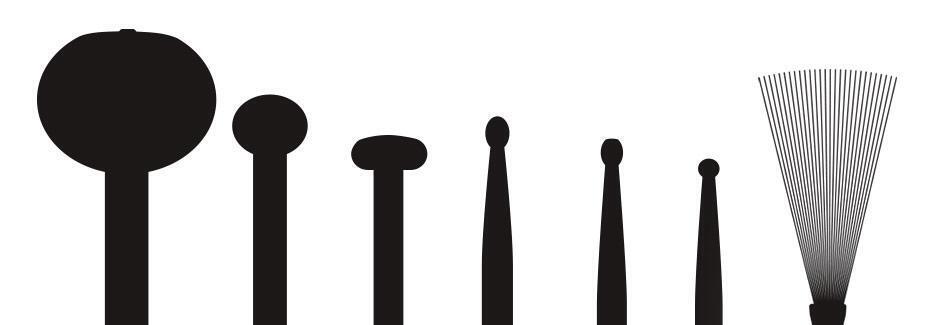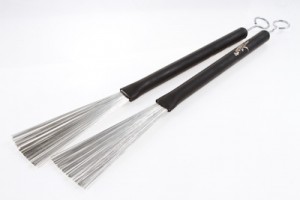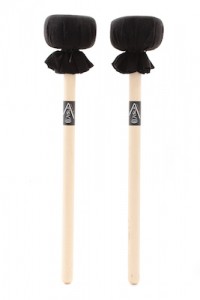How to Choose the Best Drumsticks for You
Like a golfer who wouldn’t use his driver on the green, a great drummer would probably never use heavy sticks at a jazz show. One pair of sticks can’t do it all. In fact, different styles of music call for different sticks. In this Sweetwater guide, we’ll give you info that will help you choose the drumsticks that perfectly match your style of drumming — call us your caddy.
- Types of Drumsticks
- Drumsticks: What Size?
- Drumstick Materials
- Tips: Wood vs. Nylon
- Signature Sticks
- Brushes
- Mallets
- Rods
Types of Drumsticks
- Sticks — Most often, drummers use standard, basic sticks.
- Brushes — Brushes are quieter than sticks and used for soft effects. You’ll hear them in jazz, pop, and ballads.
- Mallets — Mallets are used with several percussion instruments and are capable of producing a variety of sounds.
- Rods — Rods are louder than a brush but quieter than a stick. They’re excellent for low-volume acoustic performances.

Drumsticks: What Size?
Stick sizes are generally categorized by a letter and a number. The number represents the circumference, and the letter indicates the size and application. The lower the number, the thicker the stick. In general, thicker sticks (5A) are heavier than thinner sticks (7A). The weight of your drumsticks affects how they feel and sound. While thicker, heavier sticks provide more volume and durability, lighter sticks are thinner and easier to handle. Heavier sticks are a good choice where a lot of projection is needed, whereas lighter sticks are better for situations where finesse is required. The type of music you’re playing should indicate the weight of drumsticks you need. Aside from thickness, the typical applications of drumsticks are represented by the letters S, B, and A.
- “S” sticks are heavy and intended for street performances such as marching band.
- “B” sticks are easy to control and used by many rock drummers.
- “A” sticks are ideal for lower volume situations in a jazz combo or orchestra.
For instance, while heavy 2B sticks are perfect for rock music, 7A sticks produce a lighter sound more fitting for jazz. It may require some experimentation, but in the end, there’s nothing like playing with sticks designed for your kind of drumming. Finding drumsticks that complement your style is essential to entirely express your musical identity.
Drumstick Materials
Hickory is the most common material for drumsticks. Excellent at absorbing shock, hickory is also the wood used to make baseball bats. It’s a well-rounded wood that is both reliable and consistent. Heavier and more durable than hickory is oak. Oak is more dense and is able to last longer. Those playing metal will enjoy oak’s great rebound and momentum for blast beats. Often used in softer music, maple is a light, flexible wood that is ideal for fast playing. It provides the quickest response. Maple’s light weight makes practicing complex patterns easier. Aside from wood, some drummers prefer synthetic sticks. These are made from materials such as metal and plastic. They definitely feel different than wood sticks and offer more sound control. It’s a good idea to have a few different woods in your stick bag for different musical situations.
Tips: Wood vs. Nylon
Most common in drumsticks, wood tips produce a deep, traditional sound popular in jazz and rock. If you’re playing a snare with lots of rolls, wood tips rebound exceptionally well. You may also prefer how wood tips sound on toms if you’re a rock or pop drummer. On cymbals, wood tips create a natural sound with minimal vibration but tend to deteriorate over time. Nylon tips maintain a more consistent sound than wood tips, especially for heavy hitters. You’ll find that nylon tips last longer, particularly on cymbals or other hard surfaces. Although nylon tips lack that classic wood sound, you’ll never have to worry about chipping.
Signature Sticks

Many manufacturers offer signature sticks from some of their most prominent artists. These models are made to custom specifications and are typically variations of standard shapes and sizes. Sometimes, manufacturers have even crafted the sticks to fit the musical style of one specific drummer. Drummers with signature sticks include Neil Peart, Travis Barker, Ringo Starr, and Joey Kramer.
Brushes
Quieter than sticks, brushes are used for soft effects at low volumes and can come in a variety of configurations and sizes. Brushes produce a unique sound that drummers love in genres such as jazz, pop, and Latin. Made from a series of wires or plastic strands joined at the handle, brushes can be used in many different ways. They can be swept over the drumhead to create a constant background sound, struck like a stick to produce a very light drumbeat, or used on a cymbal or cajon. Some have an adjustable fan, while others are fixed. Brushes serve as a soft, subtle complement to other instruments.
Mallets
Mallets are sticks that are capped with cotton, cloth, or yarn condensed into a ball at the head. Some mallets have plastic or rubber ball tips. The shafts are made of birch, rattan, or synthetic materials such as fiberglass. Mallets are used with a variety of percussion instruments, including xylophones and marimbas. They’re great for large, loud drums, and they also work well with cymbals, offering a unique building sound compared to standard sticks. Mallets are capable of many different timbres depending on the instrument and the sound desired.
Rods
Also called rutes, rods are comprised of several thin sticks bound together to make one stick. First established for orchestral music, rods are now extremely popular for standard drum sets. Louder than a brush, quieter than a stick, rods offer a great balance when you need something in the middle. At low volume, rods deplete most of the energy within the stick to produce a tone that would normally be associated with loud playing. Even more, you can alter the tone by adjusting the position of the band that holds the bundle together. If you need to drive the band without dominating the track, rods are the way to go.
SHOP RODSBefore settling on a style or model, you should explore many different drumstick options. To attain certain tones and volumes, it may be necessary to have several types of sticks. However, there is one thing about drumsticks that’s unfortunate: they break. That’s why it’s never a bad idea to stash some extras just in case. For any style or genre, Sweetwater has the variety and quality you need to find your optimal drumsticks. Call us at (800) 222-4700 for friendly, knowledgeable help!







